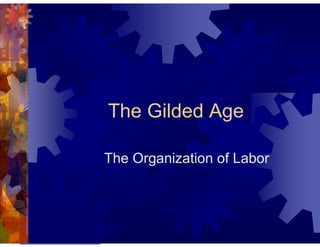
The organization-of-labor
- 1. The Gilded Age The Organization of Labor
- 2. Labor Unions • Although labor unions began forming in the early 1800s, they did not gain any significant member-ship base or bargaining power until the 1860s and 1870s. The harsh, even hazardous, working conditions arising from industrialization drove laborers to organize into unions.
- 3. Management vs. Labor ““Tools”” of Management ““Tools”” of Labor ““scabs”” P. R. campaign Pinkertons lockout blacklisting yellow-dog contracts court injunctions open shop boycotts sympathy demonstrations informational picketing closed shops organized strikes ““wildcat”” strikes
- 4. Knights of Labor • One of the first major unions was the Knights of Labor, founded in 1869. • Under the leadership of Terrence G. Powderly, the Knights demanded sweeping reforms: • Equal pay for women • An end to child labor • A progressive income tax • The union claimed a substantial membership, including women, blacks, and immigrants.
- 5. Goals of the Knights of ù Eight-hour workday. Labor ù Workers’’ cooperatives. ù Worker-owned factories. ù Abolition of child and prison labor. ù Increased circulation of greenbacks. ù Equal pay for men and women. ù Safety codes in the workplace. ù Prohibition of contract foreign labor. ù Abolition of the National Bank.
- 6. Railroad Strike • In 1885, the Knights of Labor staged a successful strike against railroad “robber baron” Jay Gould. The strike so severely crippled Gould’s operation that he had no choice but to fold. • On the strength of this victory, the Knights’ membership and political power grew. The Knights successfully supported a number of politicians for election and forced laws favorable to workers through Congress.
- 7. Haymarket Riot • The Knights’ power waned after a series of unauthorized strikes became violent. • The Haymarket Riot in Chicago in 1886 was intended to protest police brutality but it got out of hand. • Someone threw a bomb into the crowd, killing a police officer. In the resulting chaos, nine people were killed and close to sixty injured. • Prominent leaders of the Knights of Labor were convicted of inciting the riot, and public support for the union declined.
- 8. American Federation of Labor • To salvage the labor movement, craft laborers who had been members of the Knights of Labor broke off and formed the American Federation of Labor (AFL). Whereas the Knights of Labor had an open membership policy and called for sweeping reforms, the AFL, under the leadership of Samuel Gompers, catered exclusively to skilled laborers and focused on smaller, more practical issues: • Increasing wages • Reducing hours • Imposing safety measures.
- 9. How the AF of L Would Help the Workers ù Catered to the skilled worker. ù Represented workers in matters of national legislation. ù Maintained a national strike fund. ù Evangelized the cause of unionism. ù Prevented disputes among the many craft unions. ù Mediated disputes between management and labor. ù Pushed for closed shops.
- 10. Industrial Workers of the World • More radical labor organizations also emerged, most notably the Industrial Workers of the World, nicknamed the Wobblies, founded in 1905. More famous for their militant anti-capitalism than for being large or influential, the Wobblies never grew to more than 30,000 members before fading away in about 1920.
- 11. International Workers of the World (“Wobblies”)
- 12. “Big Bill” Haywood of the IWW Violence was justified to overthrow capitalism.
- 13. The Hand That Will Rule the World One Big Union
- 14. Mother Jones: “The Miner’s Angel” Mary Harris. Organizer for the United Mine Workers. Founded the Social Democratic Party in 1898. One of the founding members of the I. W. W. in 1905.
- 15. Labor Strikes • Between 1880 and 1905, union activity in the United States led to well over 35,000 strikes. • As evidenced by the Haymarket riot, these demonstrations at times erupted into violence.
- 16. Strike-Related Violence • Major strikes and outbreaks of strike-related violence during the later nineteenth century tended to impair the labor cause instead of advance it. Public sympathy for unions plummeted, companies imposed anti-union hiring policies, and the Supreme Court authorized the use of injunctions against strikers.
- 17. Railroad Strike of 1877 • The Railroad Strike followed the onset of a national economic recession in 1877. Railroad workers for nearly every rail line struck, provoking widespread violence and requiring federal troops to subdue the angry mobs. The strike prompted many employers to get tough on labor by imposing an anti-union policy: they required workers to sign contracts barring them from striking or joining a union. Some employers even hired private detectives to root out labor agitators and private armies to suppress strikes.
- 18. Homestead Strike of 1892 • Workers staged the 1892 Homestead Strike against Carnegie Steel Company to protest a pay cut and seventy-hour workweek. Ten workers were killed in the riot. Federal troops were called in to suppress the violence, and non-union workers were hired to break the strike.
- 19. The Pullman Strike of 1894 • In the 1894 Pullman Strike, Eugene Debs led thousands of workers in a strike against the Pullman Palace Car Company after wages were slashed. The courts ruled that the strikers violated the Sherman Antitrust Act and issued an injunction against them.
- 20. Eugene Debs • When the strikers refused to obey the injunction, Debs was arrested and federal troops marched in to crush the strike. In the ensuing frenzy, thirteen died and fifty-three were injured.
- 21. Organized Labor Lost Strength • The Supreme Court later upheld the use of injunctions against labor unions, giving businesses a powerful new weapon to suppress strikes. Organized labor began to fade in strength, and did not resurge until the 1930s.
- 23. The Rise & Decline of Organized Labor